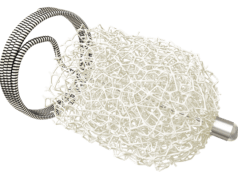
A retrospective evaluation of 600 fenestrated or branched endovascular aneurysm repairs (F/BEVARs) for the treatment of complex aneurysms revealed that fewer than one in five patients experienced an intraoperative adverse event, according to a press release announcing study results published in the March 2022 edition of the Journal of Vascular Surgery.
Thoracoabdominal aortic aneurysm repair is among the most complex and serious operations in the realm of surgery, the press release notes. Endovascular repair of these aneurysms is now established as a viable alternative to open surgical repair, and, according to the principal author, Gustavo Oderich (University of Texas Health Science Center, Houston, USA) “studies have demonstrated superior results to open repair.”
“However, despite many technical improvements in complex endovascular repairs, the procedure remains technically demanding with significant risks. Technical failures indeed may result in disastrous complications such as loss of a kidney, bowel or spinal ischaemia.”
As reported in the March 2022 edition of the Journal of Vascular Surgery, the aim of this study was to review the incidence of intraoperative adverse events and the impact on outcomes of F/BEVAR for the treatment of complex aortic aneurysms.
The authors reported on 600 consecutive repairs performed at the Mayo Clinic between 2007 and 2019. The overall 30-day mortality was 2% and there were 122 intraoperative adverse events, defined as any intraoperative complication or technical problem requiring an additional or unplanned procedure among 105 patients (18%). The most frequent events included 55 target arteries, 46 access, and seven graft complications.
Although intraoperative adverse events did not affect patient survival (odds ratio of 1), suggesting the intraoperative rescue manoeuvres were successful, there were more major adverse events in the intraoperative adverse event group, mostly due to acute kidney injury (27% vs. 11%, p<0.001). Risk factors for the intraoperative adverse events included female sex (odds ratio 2.5), presence of target artery stenosis (odds ratio 2), and Crawford Extent II aneurysm (odds ratio 1.9).
“Data on the incidence of intraoperative adverse events during F/BEVAR and the clinical sequelae has not been previously described in detail,” said Oderich. “This large single-centre study showed that intraoperative adverse events were present in 18% of patients who underwent this procedure, two-thirds of which required additional procedures to treat the complications.
“Endovascular technology continues to evolve. Novel devices have added preloaded systems, lower profile fabric, and steerable catheters and sheaths to minimise procedural difficulty.” The study also underscores the need for not only careful treatment planning but also for operators should have an armamentarium of skillsets and devices to address these intraoperative adverse events.













